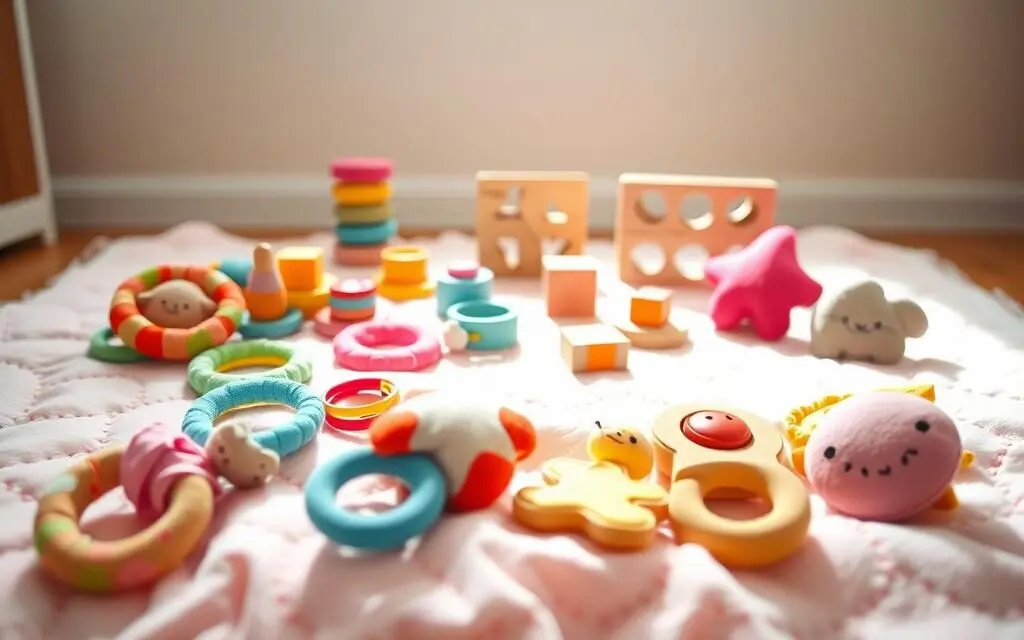Managing family finances on one income is tough for moms. It’s key to make a budget that meets your family’s needs.
Making easy diy baby toys and homemade baby toys is fun and saves money. You can craft simple baby toy crafts that are fun and won’t break the bank.

Being smart with your spending helps build a secure financial future for your family.
Key Takeaways
- Create a budget that works for your family
- Find ways to save on childcare and entertainment
- Make the most of your single income
- Prioritize your financial goals
- Stay committed to your financial plan
The Reality of Managing Family Finances on One Income
Managing family finances on one income is a big challenge. For many mothers, it’s a big job to handle the budget. They have to balance different expenses and financial needs carefully.

Common Challenges for Single-Income Families
Single-income families face unique money problems. They have less money coming in and more for childcare and household costs. “The biggest challenge is not just the reduced income, but the increased financial stress that comes with it,” says a financial advisor.
Moms in these families need to get creative with their budget. They can make do-it-yourself infant toys and homemade baby sensory toys. These are affordable and fun for their kids.
The Emotional Side of Financial Management
Managing family finances on one income can be emotionally tough. Financial stress can cause anxiety and tension. It’s key for moms to recognize these feelings and ask for help when needed.
Doing things like baby toy tutorials can be a good way to cope. It helps manage stress and can be a fun activity.
Why Traditional Budgeting Advice Often Falls Short for Moms
Traditional budgeting advice doesn’t always work for single-income families. Moms need advice that fits their unique financial situation. This might mean adjusting budgeting rules or finding new ways to save money without cutting down on what’s important.
Assessing Your Current Financial Situation
Understanding your financial situation is key to managing your family’s money well. It’s about knowing your income, expenses, and how they affect your cash flow.
Calculating Your Total Monthly Income
First, figure out your total monthly income from all sources. This includes your salary, side hustles, and other income. Stay-at-home moms might also earn from freelance work or selling handmade baby playthings.
Identifying All Expenses and Financial Obligations
Then, list all your expenses and financial duties. This includes rent, utilities, groceries, and debt payments. A budgeting app can help. Think about costs for kids, like childcare, and find cheaper options like toddler-friendly diy toys.
Understanding Your Cash Flow
Knowing your cash flow is vital. It’s the difference between what you earn and what you spend. A positive cash flow means you have extra money. A negative cash flow means you’re in financial trouble. Regularly reviewing your cash flow helps you adjust, like by earning more from easy baby toy projects or spending less.
| Income Source | Monthly Amount |
|---|---|
| Salary | $4000 |
| Side Hustle | $500 |
| Total | $4500 |

Creating a Realistic Family Budget Framework
Creating a family budget is key to managing money well. It means knowing your income, tracking what you spend, and making choices that fit your family’s needs and goals.
The 50/30/20 Budget Rule Adapted for Families
The 50/30/20 rule is a common way to budget. It says to spend 50% on needs, 30% on wants, and 20% on saving and paying off debt. Families might adjust this to fit their unique costs, like childcare or school fees. For example, families with babies might spend more on baby toys and childcare.
Digital vs. Paper Budgeting Systems
Whether to use digital or paper budgeting depends on what you like best. Digital tools, like apps, make tracking easy and automatic. Paper systems, on the other hand, are hands-on and can teach kids about money by sorting expenses, like saving for five below toys.
Involving Your Partner in Financial Decisions
It’s important to involve your partner in budgeting. Talking about money goals, spending, and saving regularly helps make smart choices. This could be planning family outings or buying monster inc toys for the kids. Working together ensures you both are on the same financial path.
Essential Expense Categories for Family Budgeting
Managing family finances on one income is crucial. You need to know the key expense categories. These categories are the foundation of your family budget and affect your financial health.
Housing and Utilities Management
Housing costs are often the biggest for families. This includes rent or mortgage, property taxes, and insurance. Utilities like electricity, water, and gas also play a big role.
To cut down, think about downsizing or negotiating with service providers. Bundling services can sometimes lead to discounts.
Food and Grocery Strategies
Food expenses can eat into a single-income budget. Planning meals, using coupons, and buying in bulk can help. Shopping at local farmers’ markets or using cashback apps can also save money. Smart grocery shopping is essential for this category.
Transportation Costs
Transportation costs, like car payments, insurance, gas, and maintenance, add up fast. Saving can be done by carpooling, using public transport, or regular vehicle maintenance. Choosing a vehicle wisely can also save money.
Childcare and Education Expenses
Childcare and education costs are a big financial challenge for many families. Look into public schooling, childcare cooperatives, or tax-advantaged savings plans. Investing in baby development toys or wooden toys that are durable and educational can be a good choice. It might reduce the need for frequent replacements or extra educational resources.
By focusing on these key expense categories and using smart management strategies, single-income families can handle their financial challenges. This helps them work towards a more stable financial future.
Smart Strategies for Cutting Household Expenses
Cutting household expenses doesn’t mean you have to give up quality of life, even on one income. A few simple strategies can help families save a lot and get financially stable.
Meal Planning and Grocery Shopping Tactics
Meal planning and smart grocery shopping are key to saving money. Look for sales and plan meals around them. Use coupons, buy in bulk, and shop at discount stores to save even more.
- Plan meals around weekly sales
- Use coupons and discount codes
- Buy non-perishable items in bulk
Reducing Utility Bills Without Sacrificing Comfort
Lowering utility bills doesn’t mean you have to be uncomfortable. Simple changes can make a big difference. Use energy-efficient appliances, turn off lights and electronics, and adjust your thermostat.
- Use energy-efficient appliances
- Turn off lights and electronics when not in use
- Adjust thermostat settings
Finding Affordable Family Entertainment
Entertainment doesn’t have to cost a lot. Look for free or low-cost activities like visiting parks, having picnics, or playing games at home. Libraries and museums are also great for affordable fun.
Clothing and Household Items on a Budget
Save money by buying second-hand clothes and items, shopping during sales, and doing DIY projects. Thrift stores, garage sales, and online marketplaces are full of affordable, gently used items.
- Shop during sales or clearance events
- Consider second-hand or thrift stores
- Use DIY projects to repurpose old items
By using these strategies, families can cut their expenses and achieve financial stability.
Budgeting for Moms: How to Manage Family Finances on One Income
Managing family finances on one income is more than just tracking expenses. It’s about a detailed plan for money management. Moms need practical strategies that meet their family’s needs.
Weekly Money Management Routines That Take Less Than 30 Minutes
Managing your money weekly can take less than 30 minutes. Here are some tasks to include:
- Track your expenses for the week
- Review your budget and make adjustments as needed
- Plan your meals and make a grocery list
By spending a short time each week, you can keep your finances in check. This helps you make smart money choices.
Monthly Budget Review Process
A monthly budget review is key to staying on track with your financial goals. Compare your spending to your budget, and find ways to improve. This helps you adjust your budget to meet your financial goals.
Seasonal Budget Adjustments for Holidays and School Expenses
Plan for seasonal costs like holidays and back-to-school. Save a bit each month to avoid last-minute money worries. Make a list of expected expenses and plan how to pay for them.
Using Cash Envelope System for Problem Spending Areas
The cash envelope system helps with spending too much on things like dining out or entertainment. Use a set amount of cash for these areas to stay within your budget and cut down on spending.
Using these budgeting tips can greatly help your family’s money management. Stay true to your budget and regularly check your finances. This way, you can reach long-term financial stability.
Building an Emergency Fund on a Limited Income
Creating an emergency fund on a tight budget needs careful planning and discipline. It’s key to keeping your family financially stable. Starting small and staying consistent can help you reach your goal.
Starting Small: The $1,000 Safety Net
Start with a $1,000 emergency fund. This amount helps cover unexpected costs like car repairs or medical bills. Begin by saving a bit each month. For example, saving $50 a month for 20 months will get you to $1,000.
Growing Your Fund: Aiming for 3-6 Months of Expenses
After reaching $1,000, aim to save 3-6 months of living expenses. This bigger fund helps in job loss, illness, or other big financial issues. Look at your budget to find ways to cut back on non-essential spending.
| Monthly Expenses | 3 Months Savings Goal | 6 Months Savings Goal |
|---|---|---|
| $3,000 | $9,000 | $18,000 |
| $4,000 | $12,000 | $24,000 |
| $5,000 | $15,000 | $30,000 |
Where to Keep Your Emergency Savings
Keep your emergency fund separate from your daily spending. Open a high-yield savings account. It earns interest on your savings and is still easy to access.
When to Use (and Not Use) Your Emergency Fund
Use your emergency fund for urgent and necessary expenses, like medical emergencies or car repairs. Don’t use it for non-essential things, like buying the latest gadgets or planning a vacation. You can also use some savings to make easy diy baby toys or homemade baby toys. This is a fun and affordable way to keep your kids entertained during tough times.
Tackling Debt While Managing Daily Expenses
Managing debt and daily expenses is tough for single-income families. Simple baby toy crafts can help. It’s important to find ways to save money and use it wisely.
Prioritizing Debt Repayment
Managing debt starts with making a list. List all debts from smallest to largest. Also, note the interest rates on each.
Debt Snowball vs. Debt Avalanche Methods
There are two main ways to pay off debt. The debt snowball method pays off the smallest debt first. The debt avalanche method targets the debt with the highest interest rate.
| Debt Repayment Method | Description | Benefit |
|---|---|---|
| Debt Snowball | Pay off smallest debt first | Quick wins |
| Debt Avalanche | Pay off debt with highest interest rate first | Saves money on interest |
Negotiating with Creditors
Talking to creditors can help. They might agree to a payment plan that works for you.
Avoiding New Debt Traps
To stay out of debt, make a budget. Include a safety net for surprises. Doing low-cost activities, like making baby toys, can also help you avoid spending too much.
Finding Additional Income Sources for Stay-at-Home Moms
Many stay-at-home moms want to earn money while taking care of their families. They look for jobs that fit their family’s schedule. This way, they can earn money without giving up family time.
Flexible Remote Work Opportunities That Fit Around Family Life
Today, many jobs can be done from home. This is great for stay-at-home moms. Jobs like virtual assistance, online tutoring, or freelance writing can be done when it’s best for the family.
Monetizing Skills and Hobbies
Stay-at-home moms can make money from their hobbies. For example, making do-it-yourself infant toys or toddler-friendly DIY toys can be fun. They can sell these items online or at local markets.
Passive Income Ideas for Busy Moms
Creating passive income is a smart move for busy moms. It means earning money without working too hard. Ideas include selling online courses, affiliate marketing, or investing in stocks.
Balancing Side Hustles with Family Responsibilities
It’s important to balance work and family time. Set clear boundaries and schedule your work. This way, you can earn money and still be there for your family.
Exploring these options, stay-at-home moms can help their family’s finances. They can do this while still focusing on their family’s needs.
Teaching Children Financial Responsibility Within Your Budget
Managing family finances on one income is a big job for moms. Teaching kids about money is key. It helps them develop values that last a lifetime. Start by teaching them about money in ways they can understand.
Age-Appropriate Money Lessons
Even three-year-olds can learn about money. Use handmade baby playthings or toys to show the value of saving. It’s a fun way to teach them about money.
Including Kids in Budget Discussions
Get your kids involved in budget talks. Explain how you plan for baby toys and other needs. It helps them see the value of financial planning.
| Age Group | Money Lessons | Activities |
|---|---|---|
| 3-5 | Basic saving concepts | Piggy banks, saving jars |
| 6-10 | Earning money, simple budgeting | Chores for allowance, simple budgeting worksheets |
| 11+ | Advanced budgeting, financial planning | Creating a personal budget, discussing financial goals |
Affordable Reward Systems
Use a reward system to encourage saving. A sticker chart or a small treat can motivate them. It shows the value of saving.
Handling “I Want” Moments in Stores
When your child wants something in a store, it’s a chance to teach them. Talk about impulse buying and the importance of money. Help them decide if they really need it.
Self-Care and Personal Spending on a Tight Budget
As a mom on one income, remember self-care is essential. It helps you stay present and manage your family’s needs better.
Creating a Personal Allowance That Doesn’t Break the Bank
Setting aside a small budget for personal spending can help a lot. Try to save $20 each month for something you love, like your favorite coffee or a new book.
Low-Cost Self-Care Practices
Self-care doesn’t have to cost a lot. Activities like meditation, reading, or walking can refresh you. Look for affordable options like yoga classes or community events.
Avoiding Budget Burnout
Stress from constant spending can burn you out. Include a buffer in your budget for surprises and treats. This reduces stress and makes budgeting easier.
Finding Community Support with Other Budget-Conscious Moms
Connecting with other budget-savvy moms is helpful. Join online forums or local groups to share tips and ideas. You can find affordable toys like five below toys or wooden toys for your kids and learn to manage expenses.
Conclusion: Thriving, Not Just Surviving, on One Income
Managing family finances on one income can be tough. But, with the right strategies, you can thrive. Start by checking your financial health, making a budget, and cutting down on unnecessary spending. This way, you can build a stable financial future for your family.
Choosing the right toys for your kids is like making smart financial choices. It helps your family grow strong and financially sound. This approach builds a foundation of integrity and character.
By using these strategies, you’re not just scraping by. You’re building a secure future. You can enjoy family time without worrying about money. Taking charge of your finances makes your family’s life more stable and secure.
With patience, persistence, and the right mindset, you can achieve financial stability. So, start today. Begin building a more secure tomorrow for your family.






